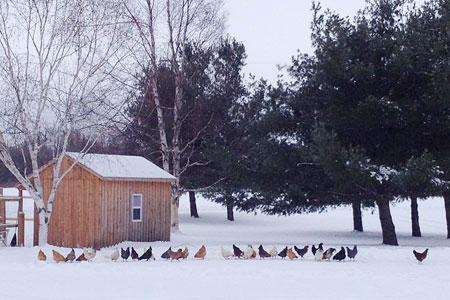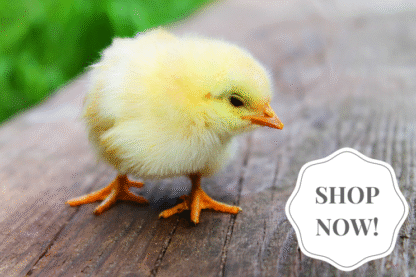
Whether or not to heat your chicken coop in winter depends on your climate, your facilities, and your type of chickens. Here are some factors to consider when trying to decide whether to heat or not to heat the chicken coop.
Avoid Frostbite
Although relative humidity tends to be low in winter months, the air inside a chicken coop gets humid from damp litter, fresh droppings, and respiration — especially when chickens spend more time inside than out.
A chicken’s feather follicles link through a network of tiny muscles that allow the chicken to raise its feathers, trapping warm air between feathers and skin. If the trapped is damp, the chicken may feel a chill.
Temperatures low enough to freeze moisture in the air can also freeze combs, wattles, and toes. Frostbite is therefore more likely to occur in damp housing than in dry housing.
Good ventilation helps reduce a coop’s humidity, helping prevent frostbite. But a really cold coop may need a heater to prevent chilling.
Keep ‘Em Laying
A hen that has trouble keeping warm will divert its energy for that purpose, rather than for laying eggs. So if the coop gets cold enough, laying may stop until the following spring.
Additionally, extremely cold weather can make a hen’s egg-laying muscles stiff. If these muscles are unable to contract enough to push the egg out, egg binding may result,
Avoid Frozen Water
Instead of heating the whole coop, sometimes all you need is a water heater or a heated waterer. Alternatively, you could fill the drinker with warm water several times a day. As long as your chickens get enough to drink, they should eat enough to stay warm in cold weather.
Keep ‘Em Eating
Chickens that don’t get enough to drink won’t eat enough to stay warm. And hens that don’t eat enough will stop laying eggs. When hens need extra energy, one option is to supplement their layer ration with a little scratch grain — no more than they can polish off within 15 to 20 minutes.
Another option is to give them more time to eat. Lighting the coop to provide a combined total of natural and artificial light of no more than 16 hours gives them more eating time, and still leaves the chickens 8 hours for uninterrupted sleep. But extra lighting won’t help if the coop is so cold that chickens spend their time huddling to stay warm.
Protect Eggs
Unless you are Johnny on the Spot about collecting winter eggs, an egg left in a too-cold coop for long may freeze. A frozen egg expands, cracking the shell.
A cracked shell lets in bacteria and other contamination, rendering the egg unsafe to eat. So deciding whether to heat or not to heat the chicken coop may come down to protecting those precious eggs until you collect them.
Reduce Disease Susceptibility
Chickens that are too cold can become susceptible to a number of health issues. For instance, newly hatched chicks that experience cold stress are more susceptible to brooder pneumonia.
Susceptibility to chronic respiratory disease increases in chickens that experience cold temperatures or poor ventilation. And chickens under cold stress may have an inadequate immune response to vaccines.
Further, cold temperatures increase a chicken’s need for oxygen. When the need for oxygen exceeds the abilities of the normally functioning heart and lungs, the heart attempts to supply the body with more oxygen by pumping more than the usual amount of blood into the lungs. Increased blood pressure between the heart and the lungs can lead to heart failure, especially in older layers.
Chickens’ Ages
Old chickens, especially if they are thin or in poor health, don’t adapt as well to cold weather. And prolonged cold stress can hasten their death. Older birds may therefore require extra warmth where younger chickens might not.
Growing chicks also require added warmth, at least until they develop enough feathers to keep themselves warm. They may need heat for longer than usual when the ambient temperature is below 70°F. The best way to determine if chicks are warm enough is to observe their behavior.
To Heat the Coop?
A chicken suffering from cold stress ruffles its feathers to trap warm air. It covers its legs and tucks its head under a wing to minimize heat escape from legs and beak, and in doing so also protects the comb and wattles from frostbite. The bird may huddle with other chickens to benefit from collective body heat.
When all that isn’t enough, the chicken shivers. Shivering increases the metabolic rate, generating more body heat, but also requires more calories. That’s why chickens eat more in winter, and if they don’t eat enough they stop laying.
So you have plenty of clues telling you whether you need to heat your coop. Additionally, a good idea is to hang a thermometer on the coop wall.
A coop heater should keep the coop temperature just above freezing. On the other hand, a coop temperature above 40°F will interfere with the flock’s health and its ability to acclimate.
Not to Heat the Coop?
Because a chicken’s body temperature is naturally high, it can remains active during cold weather. And gradual exposure to cold as the seasons progress increases tolerance for low temperatures.
As a result, chickens can pretty much keep themselves warm, provided they have adequate nutrition and drinking water, and well insulated housing that is neither damp nor drafty.
Bottom line: The routine use of a heater interferes with the chickens’ ability to acclimate through gradual exposure. And chickens that acclimate to cold temperatures usually prefer to spend most of their time outside the coop, anyway, despite the cold weather.
Helpful Links
Prepare Your Chicken Coop for Winter
5 Outstanding Chicken Breeds for a Cold Climate
And that’s today’s news from the Cackle Coop.
Gail Damerow has written numerous books about keeping poultry, many of them available from the Cackle Bookstore.

